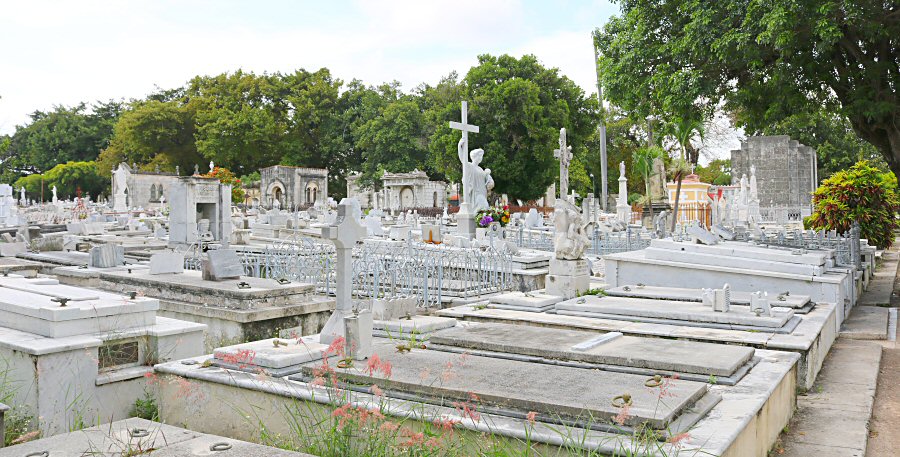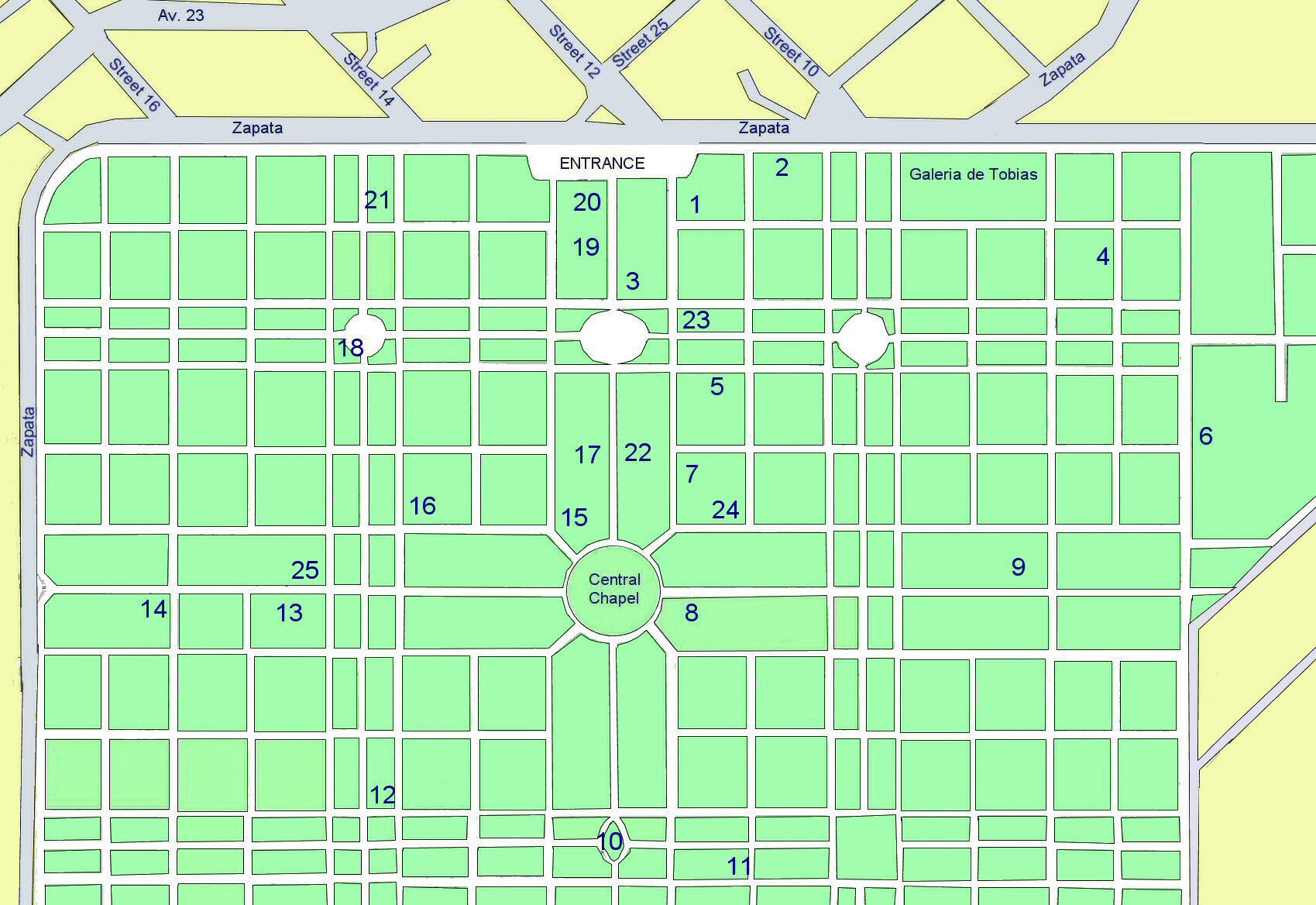The cemetery is separated from the
surrounding road by a 3-meter high perimeter wall. The wall is
composed of alternating solid cast iron fence and masonry blocks
with cross relief in its center.
There is an underground gallery between the 9th and 13th streets
facing the street A. It consisits of more than 500 niches
containing human remains. It is named after Tobias who lived in
the seventh century BC and dedicated his life to charity work,
mainly, by burying corpses.
The gallery is 95 meters long, 3 meters wide and 4 meters high.
It has two entrances at each end. Using the stone staircase with
32 steps, you can enter the gallery. The niches are arranged in
three superimposed rows on the wall. Each niche is about 70 cm
wide, 80 cm high and 2 meters deep. They are closed either with
brick, or marble tombstone. Due to inconveniet conditions of
such kind of burial, it was closed in 1974 and any new burial in
such a niche was prohibited in 1878.
The Central Chapel is built at the intersection of the central
avenues. The neo-Byzantine church has an octagonal base; a
feature, that is unique of its kind in Cuba. The number 8
symbolizes the resurection in Christ. The architect was inspired
by the Cattedrale di Santa Maria del Fiore in Florence. The
yellow painted building is composed of three concentric bodies
that have different heights.The central one is built on eight
pillars that hold the dome. The lowest one forms a gallery of
semicircular arcades that surrounds the building. It contains a
fresco of the Last Judgment.
Simple Map of the Necropolis
Cristóbal Colón
TOMBS OF SOME IMPORTANT
PERSONALITIES, MONUMENTAL TOMBS
AND TOMBS OF ARTISTIC VALUE
1 – Alejo Carpentier Valmont
(1904 - 1980), great Cuban novelist
2-
Emilio Roig de
Leuchsenring (1889 – 1964), Cuban
historian, ethnologist and journalist
3 –
Sculpture by Rita
Longa Aróstegui (1912 - 2000), the most
important Cuban sculptor of the 20th century
4 -
Carlos J. Finlay
Barrés (1833 - 1915), Cuban
epidemiologist.
for more, click here...
5 -
Dulce María Loynaz
(1902 - 1997), Cuban poet, essayist, journalist
and lawyer. She is known as the greatest Cuban
writer of the 20th century.
6 – the
eight medical
students that were shot on November 27,
1871, by being accused of desecration of the
grave of the Spanish journalist Gonzalo Castañón;
in fact this was the result of the effort of the
Spanish to suppress the struggle for freedom.
for more, click here...
7 -
Amelia
Goyri de Hoz (1877 - 1901) (Amelia Francisca de Sales
Adelaida Ramona Goyri y de la Hoz), a
high-society lady, that is known as
La
Milagrosa (the Miraculuos)
8 -
Francisco de Albear
y Fernández (1816 - 1887), Cuban
engineer.
for more click here...
9 –
Mausoleo de la
Sociedad de Beneficencia Naturales de Galicia
(Mausoleum of the Society of Natural Charity of
Galicia)
10 –
Panteón de los
Prelados (Pantheon of the Prelates;
Bishop Espada and the others)
11 -
Martyrs of the
Assault on the Presidential Palace on
March 13, 1957.
for more click here...
12 -
Mártires del
Granma (Martyrs of Granma),
for more click here...
13 -
Panteón de los
Veteranos de la Independencia (Pantheon
of the Veterans of Independence)
14 -
Jeanette Ryder
(1866 – 1931) and her dog
15 –
Nicolás Rivero y
Muñiz, Count of Rivero (1849 – 1919)
(artistic value)
16 –
Hubert de Blanck
(1856 – 1932), distinguished musician and
teacher, author of Patria, the first opera about
the independence of Cuba. His real name was
Hubertus Christian de Blanck Valet.
17 -
Monumento a los
Bomberos (Firemen’s Monument), mausoleum
for the victims of the disaster at the Isasi
hardware store in 1890.
18 -
Núñez-Gálvez
Tomb (artistic value),
for more click here...
19 -
Máximo Gómez Báez
(1836 – 1905), General in the Ten Years' War and
Commander-in-Chief of the Cuban revolutionary
troops in the War of '95
20 -
Marta Abreu de
Estévez (1845 – 1909), Cuban patriot
21 - J
osé Raúl
Capablanca y Grauper (1888 – 1942), the
legendary Cuban world chess champion from 1921
to 1927
22 -
Capilla del Amor
(Chapel of Love) which was built by Juan Pedro Baró
for his beloved wife Catalina Laza.
23 -
Dr. Fermín Valdés
Domínguez, Federico Capdevila and Dr. Domingo
Fernández Cubas, the defenders of the
eight medical students lie together in this
mausoleum
24 -
Cirilo Villaverde
de la Paz (1812 –1894), a Cuban poet,
novelist, journalist and freedom fighter. He is
best known for Cecilia Valdés, a novel about
classes and races in colonial Cuba.
25 -
Antonio Guiteras
Holmes (1906 – 1935), Cuban
politician, revolutionary and anti-imperialist.
He studied Pharmacy at the University of Havana,
where he opposed the dictatorship of
General Gerardo Machado from the University
Student Directorate.


